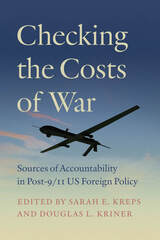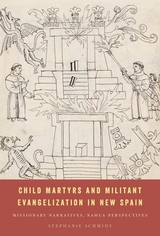4 books about de Swart, Henriette
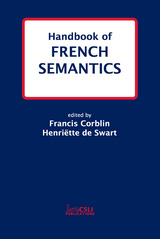
Handbook of French Semantics
Edited by Francis Corblin and Henriëtte de Swart
CSLI, 2003
This book focuses on the semantic particularities of the French language, covering five empirical themes: determiners, adverbs, tense and aspect, negation, and information structure. The specialists contributing here—including general linguists in France and French linguists in the Netherlands—take formal approaches to semantics and its interface with syntax and pragmatics, highlighting meaning in its relation to both structure and use. Their results should be of particular interest to French and Romance linguists who want to study French from a formal semantic perspective and to general linguists who are interested in cross-linguistic semantics.
[more]
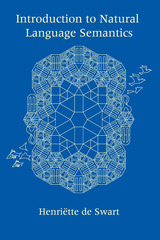
Introduction to Natural Language Semantics
Henriëtte de Swart
CSLI, 1998
Semantics is defined as the study of meaning expressed by elements of a language or combinations thereof. Utterances are not just noises or scribbles, they are used to convey information, and they are linked with kinds of events and with states of mind.
This text examines what issues semantics, as a theory of meaning, should address; determining what the meanings of words of the language are and how to semantically combine elements of a language to build up complex meanings. Logical languages are then developed as formal metalanguages to natural language. Subsequent chapters address propositional logic, the syntax and semantics of (first-order) predicate logic as an extension of propositional logic, and Generalized Quantifier theory. Going beyond extensional theory, Henri'tte de Swart relativizes the interpretation of expressions to times to account for verbal tense, time adverbials and temporal connectives and introduces possible worlds to model intensions, modal adverbs and modal auxiliaries.
This broad overview of natural language semantics should cover most of the points addressed in an introductory course. Numerous exercises punctuate each chapter and an example exam based on the materials presented is included, making this volume a perfect textbook and resource for any undergraduate or graduate-level introductory course in semantics.
This text examines what issues semantics, as a theory of meaning, should address; determining what the meanings of words of the language are and how to semantically combine elements of a language to build up complex meanings. Logical languages are then developed as formal metalanguages to natural language. Subsequent chapters address propositional logic, the syntax and semantics of (first-order) predicate logic as an extension of propositional logic, and Generalized Quantifier theory. Going beyond extensional theory, Henri'tte de Swart relativizes the interpretation of expressions to times to account for verbal tense, time adverbials and temporal connectives and introduces possible worlds to model intensions, modal adverbs and modal auxiliaries.
This broad overview of natural language semantics should cover most of the points addressed in an introductory course. Numerous exercises punctuate each chapter and an example exam based on the materials presented is included, making this volume a perfect textbook and resource for any undergraduate or graduate-level introductory course in semantics.
[more]
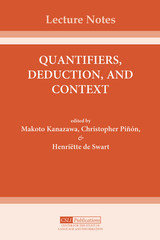
Quantifiers, Deduction, and Context
Edited by Makoto Kanazawa, Christopher Piñon, and Henriëtte de Swart
CSLI, 1996
This volume is an outgrowth of the second Workshop on Logic, Language and Computation held at Stanford in the spring of 1993. The workshop brought together researchers interested in natural language to discuss the current state of the art at the borderline of logic, linguistics and computer science. The papers in this collection fall into three central research areas of the nineties, namely quantifiers, deduction, and context. Each contribution reflects an ever-growing interest in a more dynamic approach to meaning, which focuses on inference patterns and the interpretation of sentences in the context of a larger discourse. The papers apply either current logical machinery - such as linear logic, generalised quantifier theory, dynamic logic - or formal analyses of the notion of context in discourse to classical linguistic issues, with original and thought-provoking results deserving of a wide audience.
[more]
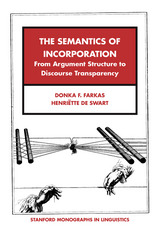
The Semantics of Incorporation
From Argument Structure to Discourse Transparency
Donka F. Farkas and Henriëtte de Swart
CSLI, 2003
Distinguishing between discourse referents and thematic arguments, the analysis of incorporation proposed by Donka Farkas and Henriettë de Swart accounts for the relationship between morphological and semantic number, the contrasts between incorporated singulars and incorporated plurals, and various "shades" of discourse transparency. The framework of Discourse Representation Theory used is a theory well-suited for connecting sentence-level and discourse-level semantics.
The analysis presented in this book has important consequences for a cross-linguistic theory of anaphora. Linguists and logicians interested in discourse structure, cross-linguistic semantics, and the relationship between morpho-syntax and meaning will find this an engaging and innovative work.
The analysis presented in this book has important consequences for a cross-linguistic theory of anaphora. Linguists and logicians interested in discourse structure, cross-linguistic semantics, and the relationship between morpho-syntax and meaning will find this an engaging and innovative work.
[more]
READERS
Browse our collection.
PUBLISHERS
See BiblioVault's publisher services.
STUDENT SERVICES
Files for college accessibility offices.
UChicago Accessibility Resources
home | accessibility | search | about | contact us
BiblioVault ® 2001 - 2025
The University of Chicago Press


